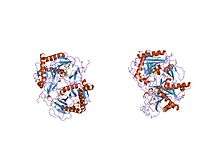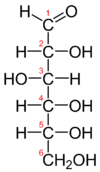Galactose-1-phosphate uridylyltransferase
| GALT | |||||||||||||||||
|---|---|---|---|---|---|---|---|---|---|---|---|---|---|---|---|---|---|
 |
|||||||||||||||||
| |||||||||||||||||
| Identifiers | |||||||||||||||||
| Aliases | GALT, entrez:2592 | ||||||||||||||||
| External IDs | OMIM: 606999 MGI: 95638 HomoloGene: 126 GeneCards: GALT | ||||||||||||||||
| |||||||||||||||||
| Orthologs | |||||||||||||||||
| Species | Human | Mouse | |||||||||||||||
| Entrez | |||||||||||||||||
| Ensembl | |||||||||||||||||
| UniProt | |||||||||||||||||
| RefSeq (mRNA) | |||||||||||||||||
| RefSeq (protein) | |||||||||||||||||
| Location (UCSC) | Chr 9: 34.64 – 34.65 Mb | Chr 4: 41.76 – 41.76 Mb | |||||||||||||||
| PubMed search | [1] | [2] | |||||||||||||||
| Wikidata | |||||||||||||||||
| View/Edit Human | View/Edit Mouse |
| Galactose-1-phosphate uridyl transferase, N-terminal domain | |||||||||
|---|---|---|---|---|---|---|---|---|---|
| Identifiers | |||||||||
| Symbol | GalP_UDP_transf | ||||||||
| Pfam | PF01087 | ||||||||
| Pfam clan | CL0265 | ||||||||
| PROSITE | PDOC00108 | ||||||||
| SCOP | 1hxp | ||||||||
| SUPERFAMILY | 1hxp | ||||||||
| |||||||||
| Galactose-1-phosphate uridyl transferase, C-terminal domain | |||||||||
|---|---|---|---|---|---|---|---|---|---|
 structure of nucleotidyltransferase complexed with udp-galactose | |||||||||
| Identifiers | |||||||||
| Symbol | GalP_UDP_tr_C | ||||||||
| Pfam | PF02744 | ||||||||
| Pfam clan | CL0265 | ||||||||
| InterPro | IPR005850 | ||||||||
| PROSITE | PDOC00108 | ||||||||
| SCOP | 1hxp | ||||||||
| SUPERFAMILY | 1hxp | ||||||||
| |||||||||
Galactose-1-phosphate uridylyltransferase (or GALT) is an enzyme (EC 2.7.7.12) responsible for converting ingested galactose to glucose.[3]
Galactose-1-phosphate uridylyltransferase (GALT) catalyzes the second step of the Leloir pathway of galactose metabolism, namely:
The expression of GALT is controlled by the actions of the FOXO3 gene. The absence of this enzyme results in classic galactosemia in humans and can be fatal in the newborn period if lactose is not removed from the diet. The pathophysiology of galactosemia has not been clearly defined.[3]
Mechanism
GALT catalyzes the second reaction of the Leloir pathway of galactose metabolism through ping pong bi-bi kinetics with a double displacement mechanism.[4] This means that the net reaction consists of two reactants and two products (see reaction above), and it proceeds by the following mechanism: the enzyme reacts with one substrate to generate one product and a modified enzyme, which goes on to react with the second substrate to make the second product while regenerating the original enzyme.[5] In the case of GALT, the His166 residue acts as a potent nucleophile to facilitate transfer of a nucleotide between UDP-hexoses and hexose-1-phosphates.[6]
- UDP-glucose + E-His ⇌ Glucose-1-phosphate + E-His-UMP
- Galactose-1-phosphate + E-His-UMP ⇌ UDP-galactose + E-His[6]
Structural studies
The three-dimensional structure at 180 pm resolution (x-ray crystallography) of GALT was discovered by Wedekind, Frey, and Rayment, and their structural analysis has found key amino acids essential for GALT function.[6]
The important amino acids that Wedekind et al. found in their structural analysis of GALT, such as Leu4, Phe75, Asn77, Asp78, Phe79, and Val108, are consistent with residues that have been implicated both in point mutation experiments as well as in clinical screening to play a role in human galactosemia.[6][8]
Clinical significance
Deficiency of GALT causes classic galactosemia. Galactosemia is a childhood disease of hereditary nature.[9] The autosomal recessive trait affects approximately 1 in every 40,000-60,000 live-born infants. Classical galactosemia (G/G) is caused by a deficiency in GALT activity, whereas the more common clinical affliction, Duarte/Classica (D/G) arises from attenuation of GALT activity.[10] Symptoms include ovarian failure, developmental coordination disorder (difficulty speaking correctly and consistently),[11] and neurologic deficits.[10] A single mutation in any of several amino acids can lead to attenuation or deficiency in GALT activity.[12] For example, a single mutation from A to G in exon 6 of the GALT gene changes Glu188 to an arginine, and a mutation from A to G in exon 10 converts Asn314 to an aspartic acid.[10] These two mutations also add new restriction enzyme cut sites, which enable detection by and large-scale population screening with PCR (polymerase chain reaction).[10] Screening has mostly eliminated neonatal death by G/G galactosemia, but the disease, due to GALT’s role in the biochemical metabolism of ingested galactose (which is toxic when accumulated) to the energetically useful glucose, can certainly be fatal.[9][13] However, those afflicted with galactosemia can live relatively normal lives by avoiding milk products and anything else containing galactose (since it cannot be metabolized), although there is the potential for problems in neurological development, or other complications, even in those who avoid galactose.[14]
Disease Database
Galactosemia (GALT) Mutation Database
References
- ↑ "Human PubMed Reference:".
- ↑ "Mouse PubMed Reference:".
- 1 2 "Entrez Gene: GALT galactose-1-phosphate uridylyltransferase".
- ↑ Wong LJ, Frey PA (September 1974). "Galactose-1-phosphate uridylyltransferase: rate studies confirming a uridylyl-enzyme intermediate on the catalytic pathway". Biochemistry. 13 (19): 3889–3894. doi:10.1021/bi00716a011. PMID 4606575.
- ↑ http://www.mondofacto.com/facts/dictionary?double+displacement+mechanism
- 1 2 3 4 Wedekind JE, Frey PA, Rayment I (September 1995). "Three-dimensional structure of galactose-1-phosphate uridylyltransferase from Escherichia coli at 1.8 A resolution". Biochemistry. 34 (35): 11049–61. doi:10.1021/bi00035a010. PMID 7669762.
- ↑ http://web.virginia.edu/Heidi/chapter19/chp19frameset.htm
- ↑ Seyrantepe V, Ozguc M, Coskun T, Ozalp I, Reichardt JK (1999). "Identification of mutations in the galactose-1-phosphate uridyltransferase (GALT) gene in 16 Turkish patients with galactosemia, including a novel mutation of F294Y. Mutation in brief no. 235. Online". Hum. Mutat. 13 (4): 339. doi:10.1002/(SICI)1098-1004(1999)13:4<339::AID-HUMU18>3.0.CO;2-S. PMID 10220154.
- 1 2 Fridovich-Keil JL (December 2006). "Galactosemia: the good, the bad, and the unknown". J. Cell. Physiol. 209 (3): 701–5. doi:10.1002/jcp.20820. PMID 17001680.
- 1 2 3 4 Elsas LJ, Langley S, Paulk EM, Hjelm LN, Dembure PP (1995). "A molecular approach to galactosemia". Eur. J. Pediatr. 154 (7 Suppl 2): S21–7. doi:10.1007/BF02143798. PMID 7671959.
- ↑ http://www.nidcd.nih.gov/health/voice/apraxia.htm
- ↑ Dobrowolski SF, Banas RA, Suzow JG, Berkley M, Naylor EW (February 2003). "Analysis of common mutations in the galactose-1-phosphate uridyl transferase gene: new assays to increase the sensitivity and specificity of newborn screening for galactosemia". J Mol Diagn. 5 (1): 42–7. doi:10.1016/S1525-1578(10)60450-3. PMC 1907369
 . PMID 12552079.
. PMID 12552079. - ↑ Lai K, Elsas LJ, Wierenga KJ (November 2009). "Galactose toxicity in animals". IUBMB Life. 61 (11): 1063–74. doi:10.1002/iub.262. PMC 2788023
 . PMID 19859980.
. PMID 19859980. - ↑ http://www.umm.edu/ency/article/000366trt.htm
Further reading
- Reichardt JK (1993). "Genetic basis of galactosemia". Hum. Mutat. 1 (3): 190–6. doi:10.1002/humu.1380010303. PMID 1301925.
- Tyfield L, Reichardt J, Fridovich-Keil J, et al. (1999). "Classical galactosemia and mutations at the galactose-1-phosphate uridyl transferase (GALT) gene". Hum. Mutat. 13 (6): 417–30. doi:10.1002/(SICI)1098-1004(1999)13:6<417::AID-HUMU1>3.0.CO;2-0. PMID 10408771.
- Reichardt JK, Belmont JW, Levy HL, Woo SL (1992). "Characterization of two missense mutations in human galactose-1-phosphate uridyltransferase: different molecular mechanisms for galactosemia". Genomics. 12 (3): 596–600. doi:10.1016/0888-7543(92)90453-Y. PMID 1373122.
- Leslie ND, Immerman EB, Flach JE, et al. (1992). "The human galactose-1-phosphate uridyltransferase gene". Genomics. 14 (2): 474–80. doi:10.1016/S0888-7543(05)80244-7. PMID 1427861.
- Reichardt JK, Levy HL, Woo SL (1992). "Molecular characterization of two galactosemia mutations and one polymorphism: implications for structure-function analysis of human galactose-1-phosphate uridyltransferase". Biochemistry. 31 (24): 5430–3. doi:10.1021/bi00139a002. PMID 1610789.
- Reichardt JK, Packman S, Woo SL (1991). "Molecular characterization of two galactosemia mutations: correlation of mutations with highly conserved domains in galactose-1-phosphate uridyl transferase". Am. J. Hum. Genet. 49 (4): 860–7. PMC 1683190
 . PMID 1897530.
. PMID 1897530. - Reichardt JK, Woo SL (1991). "Molecular basis of galactosemia: mutations and polymorphisms in the gene encoding human galactose-1-phosphate uridylyltransferase". Proc. Natl. Acad. Sci. U.S.A. 88 (7): 2633–7. doi:10.1073/pnas.88.7.2633. PMC 51292
 . PMID 2011574.
. PMID 2011574. - Flach JE, Reichardt JK, Elsas LJ (1990). "Sequence of a cDNA encoding human galactose-1-phosphate uridyl transferase". Mol. Biol. Med. 7 (4): 365–9. PMID 2233247.
- Reichardt JK, Berg P (1988). "Cloning and characterization of a cDNA encoding human galactose-1-phosphate uridyl transferase". Mol. Biol. Med. 5 (2): 107–22. PMID 2840550.
- Bergren WG, Donnell GN (1974). "A new variant of galactose-1-phosphate uridyltransferase in man: the Los Angeles variant". Ann. Hum. Genet. 37 (1): 1–8. doi:10.1111/j.1469-1809.1973.tb01808.x. PMID 4759900.
- Shih LY, Suslak L, Rosin I, et al. (1985). "Gene dosage studies supporting localization of the structural gene for galactose-1-phosphate uridyl transferase (GALT) to band p13 of chromosome 9". Am. J. Med. Genet. 19 (3): 539–43. doi:10.1002/ajmg.1320190316. PMID 6095663.
- Ashino J, Okano Y, Suyama I, et al. (1995). "Molecular characterization of galactosemia (type 1) mutations in Japanese". Hum. Mutat. 6 (1): 36–43. doi:10.1002/humu.1380060108. PMID 7550229.
- Elsas LJ, Langley S, Paulk EM, et al. (1995). "A molecular approach to galactosemia". Eur. J. Pediatr. 154 (7 Suppl 2): S21–7. doi:10.1007/BF02143798. PMID 7671959.
- Elsas LJ, Langley S, Steele E, et al. (1995). "Galactosemia: a strategy to identify new biochemical phenotypes and molecular genotypes". Am. J. Hum. Genet. 56 (3): 630–9. PMC 1801164
 . PMID 7887416.
. PMID 7887416. - Fridovich-Keil JL, Langley SD, Mazur LA, et al. (1995). "Identification and functional analysis of three distinct mutations in the human galactose-1-phosphate uridyltransferase gene associated with galactosemia in a single family". Am. J. Hum. Genet. 56 (3): 640–6. PMC 1801186
 . PMID 7887417.
. PMID 7887417. - Davit-Spraul A, Pourci ML, Ng KH, et al. (1994). "Regulatory effects of galactose on galactose-1-phosphate uridyltransferase activity on human hepatoblastoma HepG2 cells". FEBS Lett. 354 (2): 232–6. doi:10.1016/0014-5793(94)01133-8. PMID 7957929.
- Lin HC, Kirby LT, Ng WG, Reichardt JK (1994). "On the molecular nature of the Duarte variant of galactose-1-phosphate uridyl transferase (GALT)". Hum. Genet. 93 (2): 167–9. doi:10.1007/BF00210604. PMID 8112740.
- Elsas LJ, Dembure PP, Langley S, et al. (1994). "A common mutation associated with the Duarte galactosemia allele". Am. J. Hum. Genet. 54 (6): 1030–6. PMC 1918187
 . PMID 8198125.
. PMID 8198125. - Reichardt JK, Novelli G, Dallapiccola B (1993). "Molecular characterization of the H319Q galactosemia mutation". Hum. Mol. Genet. 2 (3): 325–6. doi:10.1093/hmg/2.3.325. PMID 8499924.
External links
- Galactose-1-P-Uridyltransferase at the US National Library of Medicine Medical Subject Headings (MeSH)
- GeneReviews/NIH/NCBI/UW entry on Galactosemia
- Galactosemia (GALT) Mutation Database
- GALT Protein Database

